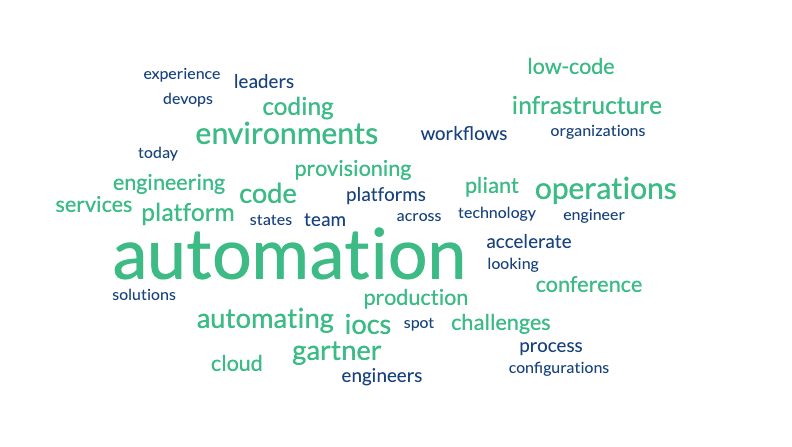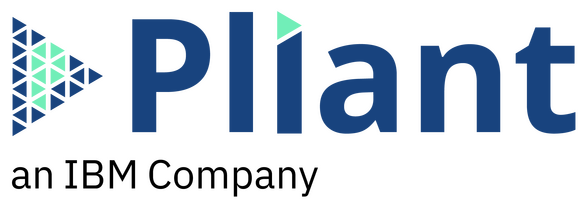Back in December, the Pliant team attended Gartner’s 2023 IT Infrastructure, Operations & Cloud Strategies (IOCS) Conference in Las Vegas, NV. 🌆
This large-scale IT event attracts operation, engineer, and DevOps leaders from across the globe. Gartner states that IOCS “brings the world’s technology leaders together to hear top trends, find objective answers, and explore topic coverage in addition to best practices.”
In this blog, we’re looking at our team’s most important insights from the Gartner IOCS Conference. We’ll kick things off with what we feel is a bright spot in today’s automation landscape.

The Brightest Spot in Automation Today
In Gartner’s State of Infrastructure and Operations Automation survey, only 21% of I&O leaders reported high levels of success in their automation endeavors. Yet, Infrastructure and Operations leaders are broadly optimistic about the future: 85% of them see more automation in their future.
The brightest spot in automation today is provisioning, as outlined below:
- Provisioning primarily focuses on setting up new environments with familiar and commonly standardized configurations. The advantage of working in these greenfield environments is that the state of the environment is known, simplifying the process of writing automation code.
- Automating the provisioning process carries a lower level of risk compared to automating changes in production environments. This reduced risk factor enhances the reliability and security of the automation procedures.
- For the automation of application deployments, the combined expertise of Dev and DevOps teams brings strong coding skills to the table. This proficiency is crucial for developing efficient and reliable automation code.
- When it comes to automating cloud services, automation coders can rely on services that are well-abstracted, surpassing the complexity of data center services. This enhanced abstraction contributes to a smoother and more straightforward automation experience.
Leveraging the known states of greenfield environments, minimizing risks in automation processes, and tapping into the coding expertise of DevOps teams make automating provisioning and cloud services efficient and also user-friendly.
But it doesn’t come without its fair share of challenges. ❌
Infrastructure and Operations Automation Challenges
The other side of this coin is that automating ongoing operations, particularly in network, data center, and hybrid environments is much more challenging in today’s modern IT environments.
Production environments are often brownfield, meaning multi-technology with uncertain configurations and states. This makes writing automation code quite difficult. Not to mention automating changes to production services presents business risks.
An industry analyst recently shared with us, “Cloud and application provisioning is only 10% of the problem, and it’s the easy part. 90% of the problem and the cost is elsewhere.”
Here’s what was recommended at the Gartner IOCS Conference:
“Automate deployment, but don’t neglect to automate valuable operational opportunities such as change management, vulnerability remediation, and backup and disaster recovery.”
Automating ongoing operations in diverse modern IT environments, especially in brownfield production settings with varied technologies and uncertain configurations, poses significant challenges.
Let’s take a look at how organizations can overcome them with up-and-coming solutions.
Gartner IOCS Insights to Overcome These Challenges
Unfortunately, there’s no one-size-fits-all solution to these automation challenges. Instead, it’s a combination of new approaches and technologies that will deliver results. ✅
Let’s look at a few prominent solutions that we heard time and time again at the Gartner IOCS Conference:
Generative AI
Generative AI, with a co-pilot approach, can radically simplify and accelerate the production of automation code by engineers. The aim here is to support the engineer with a service that will automatically generate and propose template workflows based on verbal prompts.
The engineer can then inspect and edit the code—a task made considerably faster and more rewarding by graphical representations of the code, as provided by low-code solutions like Pliant.
Platform Engineering
Gartner defines Platform Engineering as “the discipline of building and operating self-service developer platforms for software development and delivery. A platform is a layer of tools, automation, and information maintained as products by a dedicated platform team, designed to support software developers or other engineers by abstracting underlying complexity. The goal of platform engineering is to optimize the developer experience and accelerate delivery of customer value.”
As more IT organizations turn towards this model, they will create groups that will combine engineering disciplines across technical domains as well as coding disciplines.
They will also adopt tooling and process standards that will support their work across technical domains. Market forces may drive IT Infrastructure and operations organizations to adopt these concepts as they strive to provide their customers with service levels that will compare favorably with the standards set by public cloud providers.
The Low-Code Approach
Low-code, API-first automation platforms, like the Pliant platform, are designed to accelerate the coding proficiency of engineers, making coding more accessible to other team members.
They’re also designed to make coding much faster. In a low-code, API-first solution, engineers create workflows by dragging and dropping blocks of API functionality onto a canvas. In other words, they can code complex workflows armed only with their knowledge of engineering and their process logic.
Automation platforms also include sophisticated capabilities with RBACs, API gateways, and a portal for Self-Service Apps that make publishing workflows to an organization seamless and secure. Adoption of these platforms can accelerate the progress of automation in IT infrastructure and operations.
Final Thoughts
The Gartner IOCS Conference for 2023 was a great success. It provided a transformative journey for anyone looking for a way forward in technology. It was a great experience for the Pliant team, especially getting to know the individuals on the front lines of innovation. 🎉
And even though there’s a lot of room for improvement regarding IT automation, we believe things are looking up. If you’d like to see how Pliant is leading the way with a low-code, automation-first technology, book a demo today.
